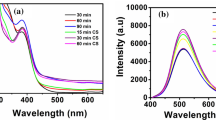Abstract
Biomedical applications require nanocrystals with a narrow emission spectra and low toxicity. One major challenge of using quantum dots (QDs) in biomedical studies has been to synthesize them in large quantities while retaining desirable optical properties. To date, no research has been carried out to scale up the synthesis of InP/ZnSe nanocrystals. In this regard we synthesized InP/ZnSe nanocrystals using lower volumes and masses and scaled up the synthesis while retaining their molar ratios. The properties of the products obtained in small scale and scaled up syntheses were compared in regard to changes in particle size, emission wavelength and the trend of fluorescence of the aliquots. The particle size for the small scale reaction was determined to be 4.18 nm. When the synthesis was scaled up by a factor of 2, 4 and 6, the sizes were found to increase to 4.31, 4.13 and 4.37 nm, respectively. We also demonstrated the ability to tune the emission wavelength by sorting the particles in the crude product to different sizes. The size sorting process gave QDs with varied emission wavelengths and also narrow emission spectra. We further demonstrated a facile method for their water solubility as well as suitability for various biological applications. The toxicity of the synthesized InP/ZnSe nanocrystals was investigated. The cytotoxicity studies were carried out using two different types of non-cancerous human cell lines, namely KMST6 and MCF-12A, which clearly showed that the nanocrystals have low toxicity and are suitable for biological applications.










Similar content being viewed by others
References
Abràmofff MD, Magalhães PJ, Ram SJ (2005) Image processing with ImageJ Part II. Biophotonics Int 11:36–43. doi:10.1117/1.3589100
Brunetti V, Chibli H, Fiammengo R et al (2012) InP/ZnS as a safer alternative to CdSe/ZnS core/shell quantum dots: an in vitro and in vivo toxicity assessment. Nanoscale. doi:10.1039/c2nr33024e
Byun HJ, Lee JC, Yang H (2011a) Solvothermal synthesis of InP quantum dots and their enhanced luminescent efficiency by post-synthetic treatments. J Colloid Interface Sci 355:35–41. doi:10.1016/j.jcis.2010.12.013
Byun H-J, Song W-S, Yang H (2011b) Facile consecutive solvothermal growth of highly fluorescent InP/ZnS core/shell quantum dots using a safer phosphorus source. Nanotechnology 22:1–6. doi:10.1088/0957-4484/22/23/235605
Chan WCW, Nie S (1998) Quantum dot bioconjugates for ultrasensitive nonisotopic detection. Science 281:2016–2018. doi:10.1126/science.281.5385.2016
Chen O, Wei H, Maurice A et al (2013) Pure colors from core—shell quantum dots. MRS Bull 38:696–702
Cho E, Jang H, Lee J, Jang E (2013) Modeling on the size dependent properties of InP quantum dots: a hybrid functional study. Nanotechnology 24:215201. doi:10.1088/0957-4484/24/21/215201
Cros-Gagneux A, Delpech F, Nayral C et al (2010) Surface chemistry of InP quantum dots: a comprehensive study. J Am Chem Soc 132:18147–18157. doi:10.1021/ja104673y
Cui J, Beyler AP, Coropceanu I et al (2015) The evolution of the single-nanocrystal fluorescence linewidth with size and shell: implications for exciton-phonon coupling and the optimization of spectral linewidths. Nano Lett 16:289–296. doi:10.1021/acs.nanolett.5b03790
Gary DC, Cossairt BM (2013) The role of acid in modulating precursor conversion in InP-QD synthesis. Chem Mater 25:2463–2469
Gary DC, Glassya B, Cossairt BM (2014) Investigation of indium phosphide quantum dot nucleation and growth utilizing triarylsilylphosphine precursors. Chem Mater 26:1734–1744. 10.1021/cm500102q
Gary DC, Terban MW, Billinge SJL, Cossairt BM (2015) Two-step nucleation and growth of InP quantum dots via magic- sized cluster intermediates. Chem Mater 27:1432–1441. doi:10.1021/acs.chemmater.5b00286
Godt J, Scheidig F, Grosse-Siestrup C et al (2006) The toxicity of cadmium and resulting hazards for human health. J Occup Med Toxicol 1:1–6. doi:10.1186/1745-6673-1-22
Joung S, Yoon S, Han C et al (2012) Facile synthesis of uniform large-sized InP nanocrystal quantum dots using tris (tert—butyldimethylsilyl) phosphine. Nanoscale Res Lett 7:93. doi:10.1186/1556-276X-7-93
Li L, Protière M, Reiss P (2008) Economic synthesis of high quality InP nanocrystals using calcium phosphide as the phosphorus precursor. Chem Mater 20:2621–2623. doi:10.1021/cm7035579
Mocatta D, Cohen G, Schattner J et al (2011) Heavily doped semiconductor nanocrystal quantum dots. Science 332:77–81. doi:10.1126/science.1196321
Mushonga P, Onani MO, Madiehe AM, Meyer M (2013) One-pot synthesis and characterization of InP/ZnSe semiconductor nanocrystals. Mater Lett 95:37–39. doi:10.1016/j.matlet.2012.12.102
Naqvi S, Samim M, Abdin MZ et al (2010) Concentration-dependent toxicity of iron oxide nanoparticles mediated by increased oxidative stress. Int J Nanomedicine 5:983–989. doi:10.2147/IJN.S13244
Park J, Kim S, Kim S et al (2010) Fabrication of highly luminescent InP/Cd and InP/CdS quantum dots. J Lumin 130:1825–1828. doi:10.1016/j.jlumin.2010.04.017
Riffle JS, Harris-shekhawat L, Carmichael-baranauskas A et al (2009) Cell uptake and in vitro toxicity of magnetic nanoparticles suitable for drug delivery. Mol Pharm 6:1417–1428
Sapsford KE, Pons T, Medintz IL, Mattoussi H (2006) Biosensing with luminescent semiconductor quantum dots. Sensors 6:925–953. doi:10.3390/s6080925
Senthilkumar K, Kalaivani T, Kanagesan S et al (2013) Wurtzite ZnSe quantum dots: synthesis, characterization and PL properties. J Mater Sci 24:692–696. doi:10.1007/s10854-012-0796-4
Sukanya D, Sagayaraj P (2015) Facile synthesis and characterization of MPA capped CdSe and CdSe/ZnS nanocrystals. Int J Chem Tech Res 7:1421–1425
Thomas A, Nair PV, George Thomas K, Thomas KG (2014) InP quantum dots: an environmentally friendly material with resonance energy transfer requisites. J Phys Chem C 118:3838–3845. doi:10.1021/jp500125v
Xie R, Peng X (2009) Synthesis of Cu-doped InP nanocrystals (d-dots) with ZnSe diffusion barrier as efficient and color-tunable NIR emitters. J Am Chem Soc 131:10645–10651. doi:10.1021/ja903558r
Yu WW, Chang E, Drezek R, Colvin VL (2006) Water-soluble quantum dots for biomedical applications. Biochem Biophys Res Commun 348:781–786. doi:10.1016/j.bbrc.2006.07.160
Acknowledgments
The authors are indebted to DST/MINTEK Nanotechnology Innovation Centre, Nation Research foundation (NRF) and the University of the Western Cape (UWC) for financial support.
Author information
Authors and Affiliations
Corresponding author
Rights and permissions
About this article
Cite this article
Kiplagat, A., Sibuyi, N.R.S., Onani, M.O. et al. The cytotoxicity studies of water-soluble InP/ZnSe quantum dots. J Nanopart Res 18, 147 (2016). https://doi.org/10.1007/s11051-016-3455-5
Received:
Accepted:
Published:
DOI: https://doi.org/10.1007/s11051-016-3455-5




